|
|
King Fergus

|
|
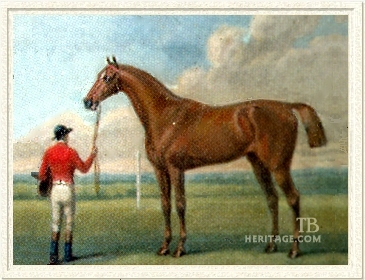 |
|
|
King Fergus was one of Eclipse's many sire sons, and, as with Eclipse sons Pot-8-Os (1773) and Joe Andrews (1778), he established a long-lived sire line. Along with Herod and Matchem, Eclipse was one of the great triumverate of early sires, and of the three, the one overwhelming sire line extant today. King Fergus was far from Eclipse's best son on the turf, but in the hands of Yorkshire trainer and breeder John Hutchison, he became one of the pre-eminent sires of the British turf in his era, and it was through him that a strong branch of Eclipse sire line flourished through the early twentieth century.
|
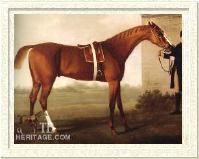
Eclipse | |
Eclipse was foaled in 1764; he was by Marske, bred by the famous and long-established Hutton stud, and out of Spiletta, who was by the preeminent mid-18th century sire, Regulus, a son of the Godolphin Arabian. He was purchased when age five, during his first season on the turf, by Dennis O'Kelly, and ran undefeated in all his races, recognized in his time as one of the greatest racehorses ever seen. Retired in 1771 to O'Kelly's Clay Hill Stud at Epsom, and moved a year before his death in 1789 to Cannons Stud in Middlesex, he sired over 340 winners. His sons and daughters, crossed with Herod blood, produced the rich matrix from which most modern thoroughbreds descend. |
King Fergus was the ninth foal of Polly, sometimes called Tuting's Polly or Creeping Polly, a 1756 mare who was by Othello (called Black and All Black when racing in Ireland). Polly was bred by Andrew Blake of Wakefield, who also bred her dam, Fanny (1751, by Tartar); Fanny was a winner at Newmarket, and at Dunstable beat two good horses, Slave and Chaunter, in three four-mile heats. In the stud of Mr. Carver, Polly bred fourteen foals between 1764 and 1781, most of whom made it to the turf. King Fergus was sold as a yearling -- or possibly was part of a not uncommon foal-sharing agreement, since the next year Carver bred and retained his sister, Polly -- to Dennis O'Kelly, who owned his sire. King Fergus was grew to a height of 16 hands, and was described as "remarkably full of bone, well shaped and free of blemishes."
King Fergus on the Turf
King Fergus was not the best racing son of Eclipse. He wasn't anywhere near as good, nor did he last as long, as Pot-8-Os, who won or walked over for thirty-four races; nor was he in the speed class of some of Dennis O'Kelly's other Eclipse sons, such as Young Eclipse and Sergeant, both of whom won the Derby, or O'Kelly's good racehorse Dungannon, or Parker's Saltram, another Derby winner. Still, with O'Kelly's astute selection of matches, he had some successes over good horses in his four seasons on the turf, running mostly at distances between two and four miles, despite running in bar shoes.
He began his career by running, at that time still unnamed, second to Miss Wickham in a sweep for three year olds at Bath, his only race in 1778. The next season he won a 500 guineas sweep at Bath, beating Cinderwench. He followed that by running third twice at Newmarket (First Spring meeting): to a Herod son, Bounceabout, in a 100 guineas sweep with eleven horses running, and to Lexicon, by Marske, in the Fortescue Stakes in which eight horses ran. He did not run again until October, at Epsom, where he received a 100 guineas forfeit from the filly Bett Bouncer in a scheduled 200 guineas match.
In 1780, age five, his most active year, he won a 100 guineas match over two miles at Newmarket's Second Spring meet against the Goldfinder son Knight Errant, and at the same meeting ran second to Pot-8-Os in a 140 Guineas race, beating a pretty good horse, Dorimant, who ran third. He went on to Epsom, where he won a four mile race in three heats, beating seven other horses, including the Herod son Epsom, the Goldfinder son Jugurtha, and the Sulphur son Don Joseph. In the fall at Newmarket he beat the Herod daughter Pomona in a 200 guineas match over three miles, and the following day won another 200 guineas match against the Herod son Guildford over the grueling four-plus mile Beacon Course. At that same meeting, he also won a 65 guineas race over the Beacon Course, beating five other horses.
In 1781 he didn't place in Newmarket's Craven Stakes in April, won by Woodpecker over fifteen horses, but he did win a minor race over the Beacon Course for £50 at the same meeting, beating the Eclipse son Whizgig, and six others at even weights, and also had a walk-over on the Duke's Course for £50. In his last race in England, he received a 100 guineas forfeit from Girandola in a 200 guineas match at Newmarket in October. After standing at stud for several years in Ireland, he was hauled out at age nine to run at the Curragh, where he placed second to Chocolate in the Lord Lieutanant's Plate. Shortly after that he was sent back to England.
King Fergus at Stud
As a less successful son of Eclipse on the turf, King Fergus was shipped off to Ireland to stand in the Croker family stud. With few patrons, he was put back into training. Just as his first youngsters were starting to win races, King Fergus was sent back to England, first to stand in London, then at Catterick in Yorkshire, where Yorkshire trainer and breeder John Hutchinson apparently saw him. Impressed with King Fergus' action, his bone, his "wonderfully clean legs," and general "mak' an' shap," he purchased the horse "for a big price," and, in 1787 King Fergus was established Hutchinson's Shipton stable, about six miles from York, for a fee of 10 guineas per mare.
In Ireland, King Fergus left Honest Tom (1785), bred by the prominent Irish politician and sportsman Thomas Conolly, and owned by racing enthusiast Colonel Charles Lumm, whose racing stable, Lumm Lodge, was located at the Curragh. Honest Tom ultimately won twenty-four races in Ireland, including five King's Plates. But it was through his Yorkshire-bred offspring, particularly Beningbrough and Hambletonian, both bred by Hutchinson, that King Fergus earned his prominent place in the annals of thoroughbred bloodlines. All of his offspring together earned over £30,000 plus various Cups, and King Fergus led the sire's list in England in 1797, interrupting the dominance of Highflyer on that list at the end of the century. King Fergus died in 1801, age 26.
For twenty-five years Beningbrough outbred Hambletonian; he sired two Oaks winners and St. Leger winner Orville, who became a top sire, leading the list in England in 1817 and 1823, and getting five classic winners. Orville's son, Derby winner Emilius, was leading sire twice, with eight classic winners to his credit between 1825 and 1840. Yet Beningbrough's sire line fizzled out when Orville failed to found a lasting line, while Hambletonian's line, limited largely to distance horses for several generations, emerged via his grandson, Blacklock, as the dominant branch of the Eclipse sire line towards the end of the 19th and early 20th centuries through the great racehorse and sire, St. Simon.
John Hutchinson
John Hutchison was a stable boy who rose to great heights as a trainer, owner and breeder at the end of the 18th and early 19th centuries. He was born at Hutton Rudby in Cleveland in 1736, where his father was a farmer and assiduous fox hunter. As a youngster he was taken to the races at Northallerton, about 12 miles from his home, and apparently fell in love with racing. Sir Robert Eden, a prominent mid-century Yorkshire turfite, gave him a position as errand boy at Castle Eden. Because he rode well and "was a nice weight," he was sent to Eden's trainer at Hambleton. As a stable-boy he was given charge of one of Eden's racehorses, Miss Western (1746, by Sedbury out of Mother Western, and so half-sister to Spiletta, dam of Eclipse), and purportedly, upon betting "every halfpenny he possessed in the world" on her to win at Hambleton in 1751, "when he had led his chestnut charge home and counted and jingled his winnings in his hat for minutes, he tossed the whole of it on the corn bin and exclaimed 'there, thank God, I shall never want for money again."
Hutchinson went on to open a training establishment in Malton, where he rode, and then trained, horses for Peregrine Wentworth of Toulston Lodge, near Tadcaster, and for Lord Grosvenor. Wentworth owned such horses as Ancaster (1768), Chatsworth (1762), and later Ormond (by King Fergus). Hutchinson then established a second stable and stud in Shipton, leaving his stable manager, named Armstrong, in charge of the Malton facility, although he was frequently there to supervise operations. For three months of the year Hutchinson sent his horses to Hambleton for training, where the turf was more forgiving than that of the hard summer ground at Malton. He became increasingly well-regarded as a trainer, and then as an owner and breeder, and was famous in the last decades of the 18th century.
He owned, trained, and/or bred such horses as Hambletonian, Beningbrough, Young Traveller, and Overton, all by King Fergus and all Doncaster Cup winners (the first three also St. Leger winners), and Oberon (by Highflyer), also a Doncaster Cup winner, and other good runners, such as Wentworth's Ormond (by King Fergus), the brothers Tickle Toby (later sent to the U.S.) and Shipton, both by Alfred. Another horse he owned and trained was Traveller (1785), who won some good north country races, such as York's Great Subscription Purse, and then was sold to Prince of Wales. At the York August meeting of 1795, Hutchinson sold Beningbrough, Hambletonian and Overton to Sir Charles Turner of Kirklentham Hall for 3,000 guineas, along with their engagements. That fall at the Doncaster meeting, Sir Charles won six of the seven races held there: Beningbrough won a match for 500 guineas, the Doncaster Stakes, and a £100 plate; Hambletonian won both the St. Leger and the Doncaster Cup, and Turner's horse Confederacy beat Evelina in a match race.
In Shipton and neighboring areas Hutchinson was known as generous and kind-hearted, "...and befriended the poor in his immediate neighborhood in a very liberal manner; he was 'one of the best." The famous north-country jockey, John Jackson, started his career with Hutchinson, and rode many of his winners. Hutchinson died at Shipton in 1806.
King Fergus Progeny
King Fergus' sons were far better than his daughters, but there is little evidence his daughters got much of a chance to run, certainly not frequently at the principal venues. Virtually all his offspring were distance horses, excelling at four miles, and a number of these true stayers were speedy enough to win at the shorter Doncaster Cup distance and the even shorter, by the day's standards, Doncaster St. Leger. If any breeder could be said to be responsible for the success of a sire, it was John Hutchinson, who bred most of King Fergus' big winners, and who supported him by running them and placing them with successful owners who were sure to keep them running. Hutchinson recognized the trend towards faster and more precocious youngsters, and the decline of distance heat racing, and he is credited with introducing two-year-old racing at Doncaster, and indeed, Beningbrough went on to become patriarch of several generations of classic winners. Still, it was through a very undistinguished, plodding grandson of Hambletonian, Whitelock, that the sire line ultimately continued.
|
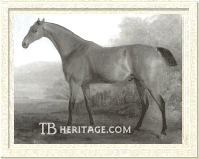
Beningbrough
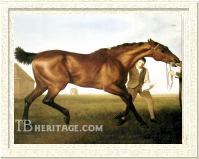
Hambletonian | |
The bay BENINGBROUGH (1791) was bred by Hutchinson from a Herod daughter, who was out of Pyrrha, a daughter of Matchem. The highlights of his four years on the turf, running for Sir Charles Turner, included winning the Doncaster Cup, the Doncaster St. Leger and some races at York and Doncaster. At the beginning of 1797, his last year on the turf, Hutchinson repurchased Beningbrough, ran him twice, and then retired him to stud at Shipton. He sired Briseus (1803) and Oriana (1804), both Oaks winners; Orville (1799), who won the St. Leger and was leading sire in England twice; Doncaster Cup winner Scud, later sire of two classic winners, and for a time it looked as if the King Fergus sire line was secure with Orville, who got five classic winners, including Derby winner Priam, but none of Priam's get, which included eight classic winners, were able to forward the line in male descent.
HAMBLETONIAN (1792), was out of Grey Highflyer, by Highflyer. He ran first for his breeder, Hutchinson, then for Sir Charles Turner, and then Sir Henry Vane Tempest, winning for them the St. Leger and the Doncaster Cup (twice), and seventeen other races and matches; only time he failed to win was when he bolted and jumped the cords at York. |
Hambletonian went to stud at Hornsey's stables in Middlethorpe, York at the modest sum of 10 guineas per mare. One of his early mares was Garforth's Rosalind, by Phoenomenon who produced Whitelock, who continued the sire line. Another son was Doncaster Cup winner Camillus, who, located at the famous Sledmere Stud, was later a moderately successful sire.
YOUNG TRAVELLER (1788, later called Lauderdale), was bred by Hutchinson from a mare by Young Trunnion. He was the first of the many Doncaster Cup winners and several St. Leger winners bred by Hutchinson. Although not favored for either race, he easily won both of them, the first horse to do so since their inception. He was piloted by John Jackson, and his St. Leger win marked the first of Jackson's eight wins of that race.
OVERTON (1788) was out of a Herod mare, and bred by Hutchison. He won the Doncaster Cup in 1792, and was part of a package, including Beningbrough and Hambletonian, sold to Sir Charles Turner in 1795. He died in 1801. His best offspring was the great Cockfighter (1796, first named Abraham Newland), who was purchased by Henry Vane Tempest after his second race at age three, and went on to win a great many top distance races, including the 4 mile Richmond Cup, the Doncaster St. Leger, the Doncaster Cup, the Oatlands at York, the Doncaster Stakes, York's Great Subscription Purse (both runnings), and the Craven Stakes at Newmarket. He met his first defeat (other than his first race at age three, when he ran off course) in a 4 mile match against Sir Solomon at Doncaster in 1801, which The Druidadjudged "the best four-mile race that was ever run over Doncaster." Another son was John o' Groat (1797), who won a good race at Catterick Bridge in 1800. A daughter, Lapwing (1797), was a good running filly.
BROTHER TO OVERTON (1792) was another distance horse of lesser ability, second to Hambletonian in the 1795 St Leger, and dead-heating with the good runner Diamond for second place to Prince Charlie in the Great Produce Stakes at York in 1796.
|
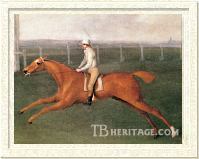
Ormond
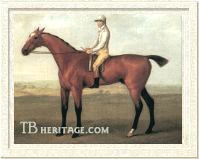
Warter
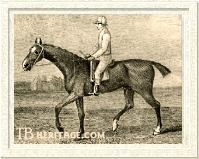
Johnny | |
ORMOND (1789), was out of Miss Cornforth, a Matchem daughter. Sold to Hutchinson's client, Peregrine Wentworth, he proved to be a good four-mile horse. His best win was the Great Subscription Purse at York over four miles in 1794, beating St. George, Caynee and six others. He also ran second to John Bull in the Great Produce Stakes at Newmarket Craven at age three, and second to Screveton in the 1796 Great Subscription Purse at York. Also at the same York meeting he lost a four mile match for 500 guineas to Beningbrough. He stood at stud in England for several years before being sold to Russia. In England he sired Louisa (1800), dam of two fair racing daughters, one of which Mouse (1812), produced 1,000 Guineas winner Young Mouse (1826), and Myszka (1842), who was dam of the French Derby winner Potocki (1854).
WARTER (1794) was out of a Highflyer mare (sister to the good race horse Escape), owned by Hutchinson, and for him produced foals by King Fergus, Overton and Ormond. Warter was her third foal, sold to Gilbert Crompton, who ran him his first two seasons, 1797-8, before selling him to J. Heathcote. His wins included in 1797, 110 guineas purse in a race at York and at Doncaster, in a grueling six heats over two miles winner of £100, beating some other good youngsters, including Stamford and Pepperpot; in 1798, he won two plates at Preston and a £50 race over three miles at Doncaster, and ran second in the Stand Plate at York, and third to Stamford and Timothy in the Doncaster Cup.
Warter ran for four more years under Heathcote's ownership, his best races in 1799 included wins in the Oatland Handicap at Newmarket, beating Oscar and Diamond; Stamford Cup, beating three others; King's Plate at Lichfield, beating three others; second to Bellisima in the Oxford Cup, and a walk-over for the King's Plate at Burford; in 1801, age seven, he won a three mile match with Jack Andrews (son of Joe Andrews) at Newmarket.
|
Sold that year to Lord Sackville, for him won the King's Plate at Guildford over four miles, beating Delpini, and at Winchester won £50. In his last season, 1802, He won a sweepstakes at Newmarket, beating Cockfighter (Doncaster Cup winner, and son of King Fergus son Overton) and Hippona (also by King Fergus, see below), and beat a younger horse, Tag, over four miles at Bilbury. Retired to stud after his 1802 season, he got few foals registered in the GSB. He died in 1812.
JOHNNY (1794) was a surviving twin out of a mare by Justice, bred by Lord Grosvenor. Sold to J.H. Durand, he ran for three years, mostly at minor venues for £50 purses, and was successful, winning at Alfriston, Sussex over two miles, at Egham over four miles and two miles, at Ascot over three miles, at Lewes, Canterbury, and Egham over four miles, at Epsom over three miles, at Winchester over four miles, and Brighton over four miles, and at Canterbury over four miles. He won a £50 purse at Newmarket in 1798, and in 1799 won a handicap plate at Newmarket and the Ladies' Plate at Lewes, beating Wrangler, Gohanna, Worthy (all top racehorses) and three others. In the stud, he sired Master Jackey (1804), winner of the inaugural running of the Ascot Gold Cup.
Other King Fergus sons of some use on the turf included: GARSWOOD (1794), out of Expectation, by Herod, owned by Sir W. Gerard, who won the four mile Richmond Cup and the Silver Cup at Northallerton at age three; POOR JACK (1788) out of a mare by Trunnion, who won a match against Grey Tretham at Brighton in 1791, after running third to him in a two mile purse at the same meeting; and DESERTER, second to the good racehorse Diamond in a three mile King's Plate at Newcastle.
Daughters of King Fergus
The chestnut HIPPONA (1794), bred by Robinson, and sold to R. Heathcote, was out of Fanny, by Weazel, and was probably the best of King Fergus' daughters on the turf. She won a match against Diamond for 200 guineas at Newmarket in the spring of 1799. In 1802 she ran third to Warter and Cockfighter in a handicap sweepstakes at Newmarket, and later that year received a compromise in a sweep at Brighton.
In the stud, the most immediately successful King Fergus daughter was an unnamed daughter (1790) out of Celia (sometimes Caelia), by Herod. To the cover of Delpini, she produced the grey 1802 Oaks winner Scotia (1799), who later bred on, producing July Stakes winner Joke (1808) and her sister Jest (1810), dam of Woodcote Stakes winner Miss Jig (1821).
ALEXINA (1788, from a Lardella, by Young Marske, Family 25), produced Houghton Lass, by Sir Peter, who ran second, twice, in the Oatlands Handicap at Newmarket at age three, and again at age six, beating some good horses, including Quiz, Orville, Parasol and Miss Coiner during her years on the turf. Purchased by Sir John Shelley of Maresfield Hall, Sussex, after the end of her career, she produced Comus (1809), sire of four classic winners and key link in the Godolphin Arabian sire line through his son, Humphrey Clinker. A number of good stakes winners descend in tail-female from Alexina, including Gladia (1874, byTournament), who established a strong female family in France (Gouverneur, Governor, Gouvernant, Genia, Gouvernail), and a great many other winners throughout the world.
Many other King Fergus daughters became part of a chain of tail-female ancestresses of good horses, among them:
TIPPLE CYDER (1788), also from a Young Marske mare, Sylvia (1783), second dam of St. Leger winner The Colonel (1825), and of Merlin (1815), later a sire of classic winners and good producing daughters. She heads the branch of Family 8 - k, which became extremely prolific and successful throughout the world.
FLORA (1789, Family 2 - c), out of the Matchem daughter, Atalanta (1769), produced two successful breeding daughters, Zara (1801, by Delpini) and a mare by Hyacinthus (1804), who spread this family's influence very far in time and distance.
ANN OF THE FOREST (1790, head of Family 5 -h), out of Matchem daughter Miss West, and a sister to Doncaster Cup winner Stargazer (later dam of Teddy the Grinder), became tail-female ancestress of what eventually became a wide-spread family of successful winners all over the world. Rough Shod (1944, by Gold Bridge), dam of Ridan, Moccasin, and Thong (Sadler's Wells and Nureyev descend from the latter), was a member of this family.
MISS MUSTON (1790, Family 9 - a), a daughter of Espersykes mare, Columbine, was fourth dam, in tail-female of Maid of Masham (1845), at the head of Family 9 - e.
--Patricia Erigero
|
|
|
|

